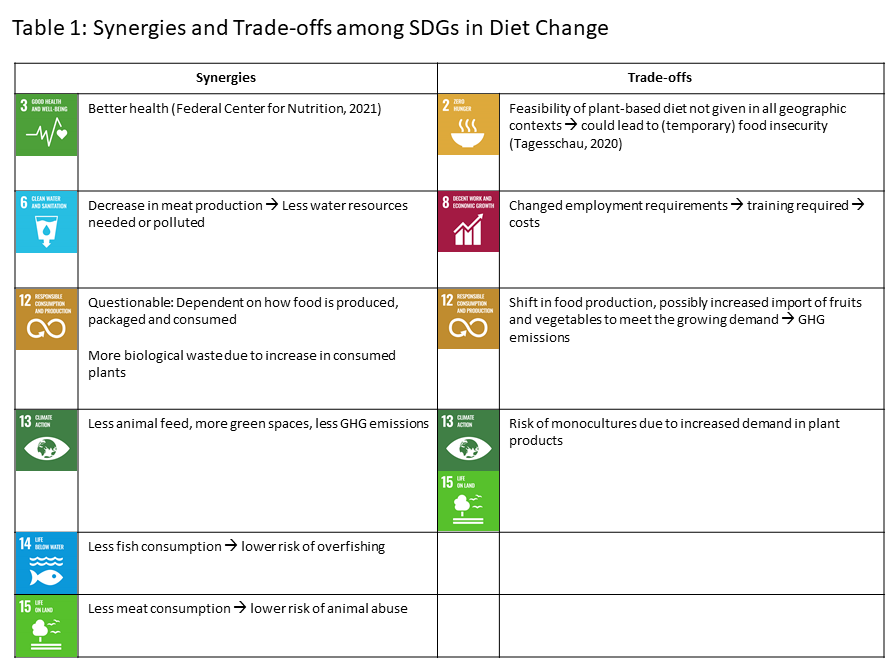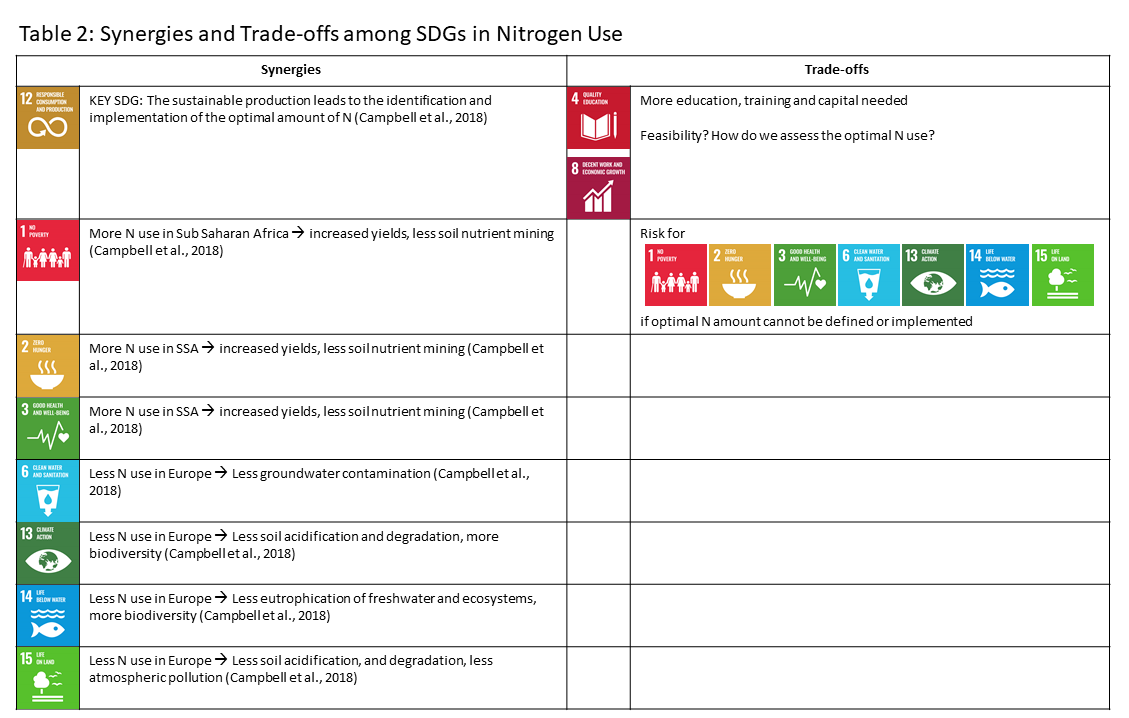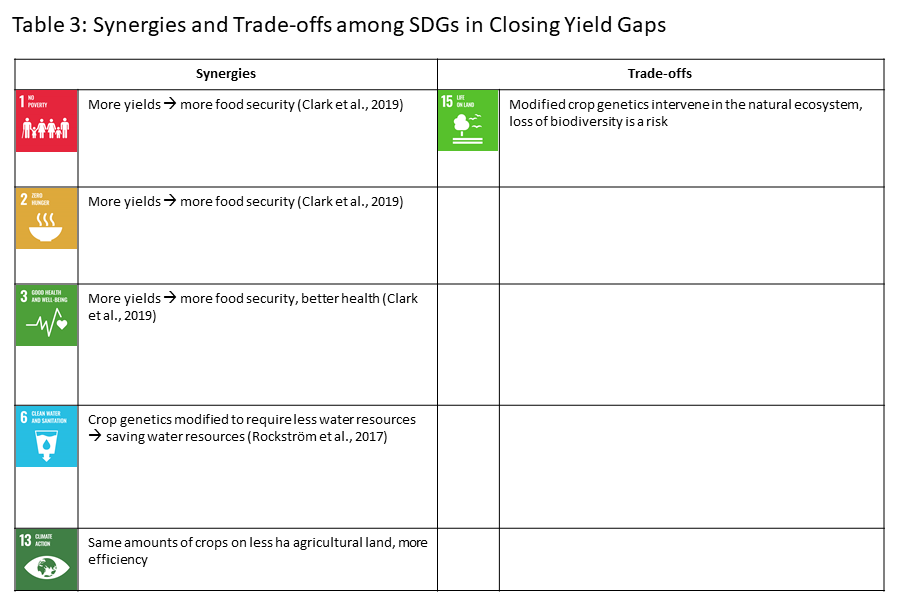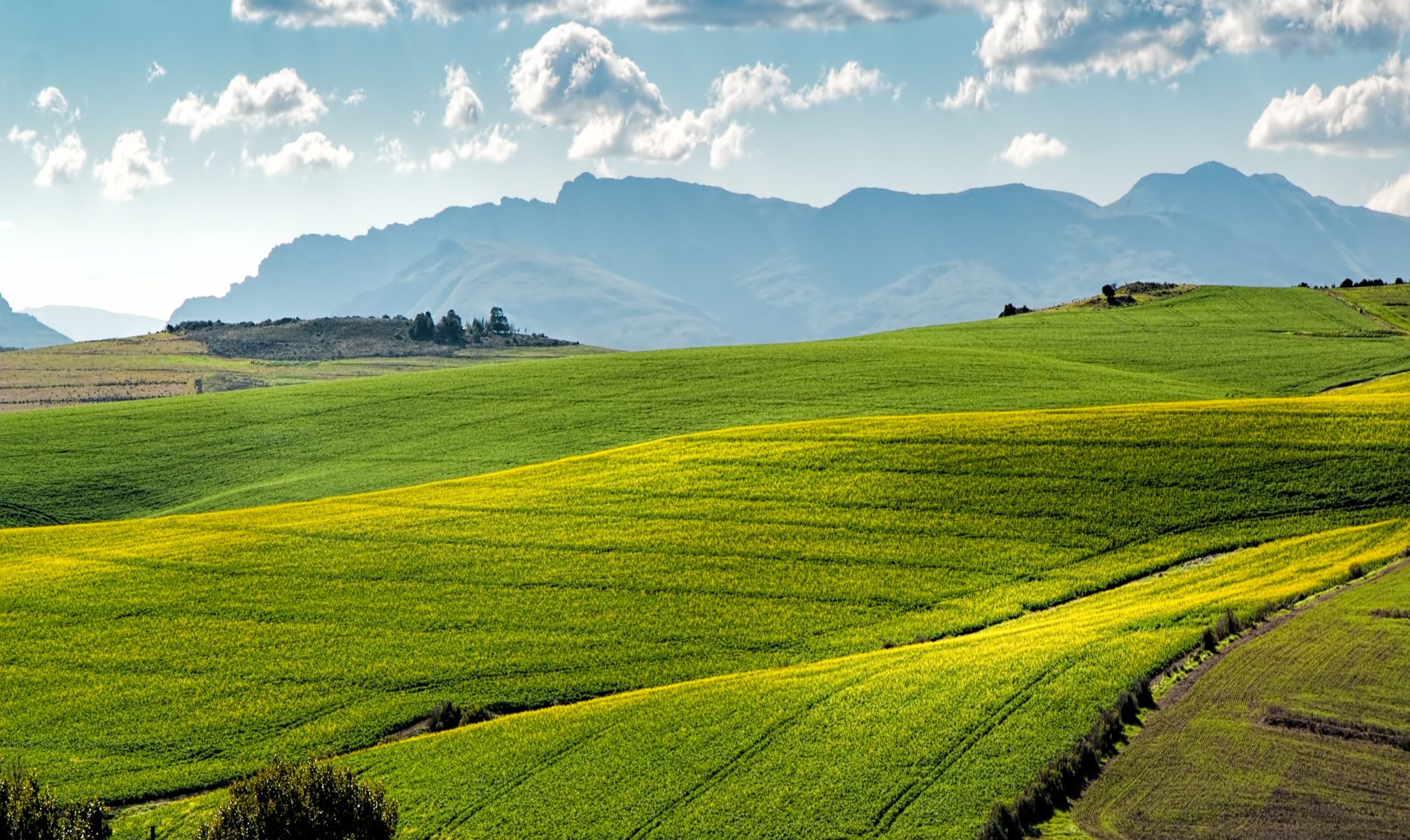By Luzie Sam*, Master Student of the Master in Sustainability, Society and the Environment at Christian-Albrechts-Universität zu Kiel, Germany
Introduction
In this article, sustainable agriculture for a transition to a sustainable global food system will be explored and positioned in the Sustainable Development Goals framework. The prime question is – How realistic is the path to sustainable agriculture? Possible synergies and trade-offs in the achievement of the SDGs are shown in an analysis. In the following, the potential of sustainable agriculture for global food system transitions will be looked at, as well as its embeddedness with the SDG framework unravelled.
The current food system is responsible for one-third of greenhouse gas emissions, which is mostly ascribed to agricultural production (Vermeulen, Campbell & Ingram, 2012). The target of keeping the global temperature to 1.5 C above preindustrial levels set in the Paris Agreement can only be achieved if greenhouse gases emitted in the food system are reduced drastically (Clark et al., 2020). The key problems to be faced are the urgency of advancing in the achievement of Sustainable Development Goal (SDG) 13 – Climate Action while simultaneously progressing in other SDGs, especially SDG 2 – Zero Hunger. One of the promising solutions for actions that promote synergies between these two goals is sustainable agriculture. This approach strives to enhance or maximise the food production to meet the needs of a growing population while being resource- saving and safeguarding the soil’s capacity to regenerate and maintain high biological quality. But how realistic is the path to sustainable agriculture and will it be enough to meet the needs of future generations while avoiding heating up the planet even further?
Conceptual Background
According to the study of Piñeiro et al. (2020), the aim of sustainable agricultural policies is to ensure environmental sustainability and farm productivity. The authors draw a direct positive link from implementing sustainable agriculture to several SDGs. Despite these positive synergies stemming from the introduction of sustainable agriculture, one must closely observe possible negative consequences on other SDGs resulting from the practices of sustainable agriculture and how these affect the achievement of other SDGs.
Rockström et al. (2017) argue that it needs a paradigm shift towards sustainable intensification of agriculture to sustain the growing human needs and develop resilience in the face of a changing climate. However, a shift towards sustainable intensification of agriculture entails technological challenges, linking to SDG 7 – Industry, Innovation and Infrastructure. According to Campbell, Hansen, Rioux, Stirling and Twomlow (2018), SDG 12 – Responsible consumption and production plays a key role in balancing out trade-offs and building synergies between SDGs.
In all research, the need for sustainable transitions in food systems is unquestioned, however, approaches and their emphasis on how to achieve and progress towards it remain various. It needs more than sustainable agriculture to achieve sustainable food systems and it needs simultaneous progress in some SDGs to advance in SDG 2 and SDG 13. The system must be designed in a way that advancements in SDG 2 or 13 support the achievement of SDG 2 or 13, while not impeding the achievement of others.
Analysis
This section presents three measures for sustainable food systems, which were defined and categorised into the synergies – positive outcomes for SDGs associated with the factor and into trade-offs – negative outcomes for SDGs associated with the factor. These are assumptions made based on literature findings and hypothesis. The tables shown do not claim to be exhaustive. This presents further research opportunities.
Dietary changes towards a plant-based diet
Only adopting a plant- rich diet globally would account for a 50% chance of achieving the limit of 1.5 C temperature increase according to the study of Clark et al. (2020). Table 1 shows the possible and expected positive and negative outcomes of implementing a global plant-based diet. This choice of diet is likely to have a positive impact on the achievement of SDG 3 and SDGs 13, 14 and 15 due to a decrease in meat production, which is a major emitter of greenhouse gas emissions. A dietary change to this extent would on the other hand possibly have temporary negative impacts on SDG 8 caused by the changing requirements in the meat industry. Most importantly, the feasibility of such a global diet is questionable and might even have negative implications for SDG 2 in some geographical spheres. The agricultural land conditions and capacities in such contexts imply that they can hardly be used for plant production. Removing meat and fish from the diets can have negative impacts on food security and the health of household members.

Agricultural precision through optimal nitrogen use
SDG 12 plays a crucial role in the identification and implementation of optimal nitrogen levels in agriculture (Campbell et al., 2018). If an optimal amount can be identified and applied, this has major positive effects for various SDGs (Table 2). In Sub-Saharan Africa, nitrogen use must be increased to come to better agricultural yields and in other spaces like Europe, nitrogen use must be reduced to avoid groundwater contamination, soil acidification, degradation, and loss of biodiversity (Campbell et al., 2018). In this example, the synergies clearly outweigh the trade-offs, however, the same question applies here as above. How feasible is the implementation of optimal nitrogen amounts?

Agricultural precision through closing yield gaps
Agricultural efficiency can likewise be obtained by closing yield gaps, improving crop genetics, and implementing agronomic practices (Clark et al., 2019). In Table 3, one can see that the potential synergies resulting from the implementation of this approach outweigh the potential trade-offs by far. Precision farming and improved crop genetics can lead to more yields, which supports the achievement of SDGs 1, 2 and 3. Furthermore, crop genetics can be modified to be needing less water resources, which has positive implications for SDG 6 and 13. In the achievement of SDG 15, trade-offs could be identified. Genetically modifying crops entails a risk for the natural biodiversity outside the farm space. Crops’ genes are known to get mixed through winds between modified and unmodified farmlands.

Conclusion
Drawing a line back to the research question, it becomes apparent that sustainable agriculture must be a driver in the transition to sustainable food systems, however that its potential should not be overrated, or its feasibility challenges underestimated. No approach in sustainable agriculture or in any other field is without trade-offs. It is about identifying those trade-offs and internalising the outcomes so that all negative impact on the achievement of SDGs can be dealt with.
On a closing note, it is suggested that more attention is paid to the negative effects of interventions in agriculture and to form more efficient policies and create more holistic, sound systems. There is no one size fits all method, which can lead the way to sustainable food systems, however, small and carefully made steps in consumption and production changes will constitute the sustainable transition.
*corresponding author: Luzie Sam at luzie.siegel@gmail.com
Reference
Campbell, B. M., Hansen, J., Rioux, J., Stirling, C. M., & Twomlow, S. (2018). Urgent action to combat climate change and its impacts (SDG 13): transforming agriculture and food systems. Current Opinion in Environmental Sustainability, 34, 13-20.
Clark, M. A., Domingo, N. G., Colgan, K., Thakrar, S. K., Tilman, D., Lynch, J., … & Hill, J. D. (2020). Global food system emissions could preclude achieving the 1.5° and 2° C climate change targets. Science, 370(6517), 705-708.
Federal Center for Nutrition. (2021). Planetary health diet: Speiseplan für eine gesunde und nachhaltige Ernährung. Startseite – BZfE.
Global Change Data Lab. (2018). Goal 2: Zero hunger – SDG tracker. Our World in Data.
Herrero, M., Thornton, P. K., Mason-D’Croz, D., Palmer, J., Bodirsky, B. L., Pradhan, P., … & Rockström, J. (2020). Articulating the effect of food systems innovation on the Sustainable Development Goals. The Lancet Planetary Health.
Lambin, E. F., Kim, H., Leape, J., & Lee, K. (2020). Scaling up Solutions for a Sustainability Transition. One Earth, 3(1), 89-96.
Liu, J., Hull, V., Godfray, H. C. J., Tilman, D., Gleick, P., Hoff, H., … & Li, S. (2018). Nexus approaches to global sustainable development. Nature Sustainability, 1(9), 466-476.
Loboguerrero, A. M., Campbell, B. M., Cooper, P. J., Hansen, J. W., Rosenstock, T., & Wollenberg, E. (2019). Food and earth systems: priorities for climate change adaptation and mitigation for agriculture and food systems. Sustainability, 11(5), 1372.
Markard, J., Geels, F. W., & Raven, R. (2020). Challenges in the acceleration of sustainability transitions. Environmental Research Letters. Retrieved from
McNeill, D. (2019). The Contested Discourse of Sustainable Agriculture. Global Policy, 10, 16-27.
Pereira, L. M., Drimie, S., Maciejewski, K., Tonissen, P. B., & Biggs, R. O. (2020). Food System Transformation: Integrating a Political–Economy and Social–Ecological Approach to Regime Shifts. International Journal of Environmental Research and Public Health, 17(4), 1313.
Piñeiro, V., Arias, J., Dürr, J., Elverdin, P., Ibáñez, A. M., Kinengyere, A., … & Torero, M. (2020). A scoping review on incentives for adoption of sustainable agricultural practices and their outcomes. Nat Sustain 3, 809–820.
Rockström, J., Williams, J., Daily, G., Noble, A., Matthews, N., Gordon, L., & Smith, J. (2017). Sustainable intensification of agriculture for human prosperity and global sustainability. Ambio, 46(1), 4-17.
United Nations. (2020). Goal 2. United Nations Department of Economic and Social Affairs.
Vermeulen, S. J., Campbell, B. M., & Ingram, J. S. (2012). Climate change and food systems. Annual review of environment and resources, 37, 195-222.
Williams, S., & Robinson, J. (2020). Measuring sustainability: An evaluation framework for sustainability transition experiments. Environmental Science & Policy, 103, 58-66.



